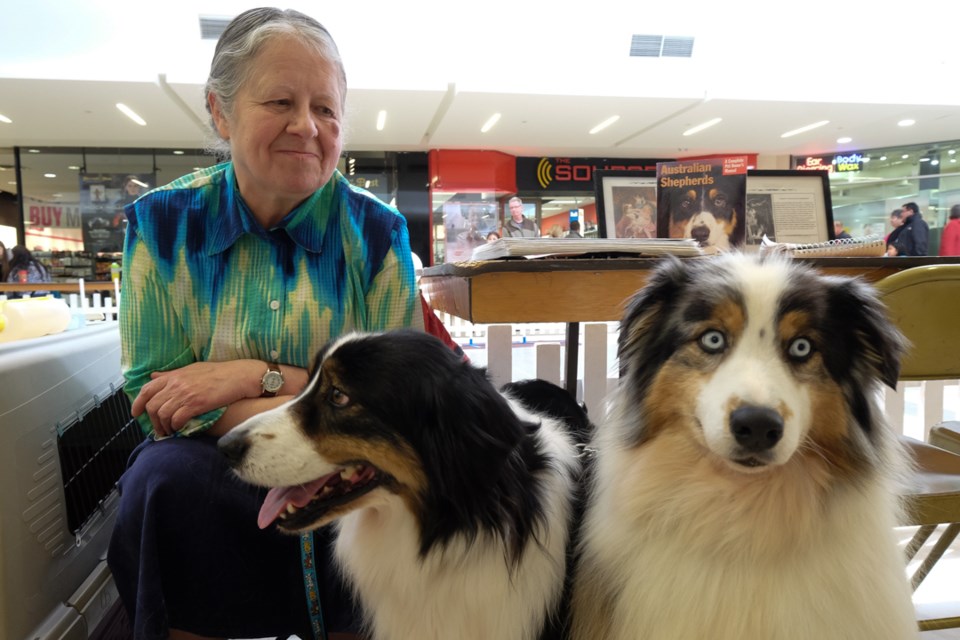If there is a terrorist attack or other tragedy in North America, Katie-Lynn may be one of the dogs called in to help with the healing process.
Golden Retriever Katie-Lynn is one of about 300 dogs that are part of the HOPE Animal-Assisted Crisis Response (AACR), an organization that provides “comfort dog support to individuals affected by crises and disasters.”
Dogs with HOPE AACR have responded to 9-11, Hurricane Katrina, the Virginia Tech shooting, and several other major situations across the United States.
Katie-Lynn’s owner, Nick Meier, brought her up to Sault Ste. Marie from DeTour Village in the Upper Peninsula, to take part in the ‘Meet the Breed’ dog show put on by the Sault Ste. Marie Kennel Club at the Station Mall on Saturday.
Katie-Lynn has a remarkable story.
At the age of 3, Katie-Lynn was diagnosed with cancer, her owners couldn’t afford to amputate her right hind leg and potentially save her life and so she was taken in by an organization called Golden Rescue who are committed to paying for the surgery and finding Katie-Lynn a new home.
Meier had just lost a previous dog he had to cancer and was connected with Katie-Lynn through the Golden Rescue just two weeks later.
Meier trained Katie-Lynn to first be a therapy dog and then went through further training to become a crisis response dog.
Crisis response dogs are basically dogs that help by sitting next to people and letting themselves get petted and hugged.
Their skill is being able to perform these duties in some of the worst situations.
Perhaps Katie-Lynn’s most trying response situation was when she was dispatched two days after the Washington Navy Yard mass shooting that happened on September 16, 2013 in which 12 people lost their lives.
Meier told the story of how meeting Katie-Lynn helped one victim who had lost two friends in the mass shooting.
“I remember I was walking around a set of cubicles. There was a woman that came out and sat on the floor with Katie-Lynn and just started petting her. I could just see the pain in her face and all that pain and agony leave as she stroked Katie-Lynn’s head. She then went back to her cubicle and never said anything. I ran into the woman almost two years later and she told me that when she met with Katie-Lynn she had been under an incredible amount of stress and Katie-Lynn just gave her that comfort and support she needed at the time,” said Meier.
Katie-Lynn has also been called in to help give therapy to students in four separate incidents in the Upper Peninsula, two of which were after the deaths of students at schools in Sault Ste. Marie, Mi.
“When we met with the senior class of this one student who was killed by a drunk driver none of the students would say anything at first. They just sat there; some of them were almost like zombies. One of the crises-councilors got one of the students to go on the floor and pet the dog, then got another student to pet the other dog and, after that, the floodgates opened and the students started to talk about how they felt,” he said.
Meier said he has seen visibly distressed students in crises situations have the stress almost pour out of them just from sitting and petting these dogs.
“Katie-Lynn and dogs like her are very very good at sensing stress in other people. They help open the doors for the councilors and assist them in what they have to do,” he said.
Meier said crises response training comes after the dogs first go through regular obedience training and then through therapy dog training.
Crisis response dogs perform similar roles to therapy dogs but they are trained to work in less predictable and more intense situations, said Meier.
As part of their training, crisis response dogs and their owner first undergo a suitability screening.
Once deemed suitable they do 30 hours of training that includes exposure to fire trucks and fire rescue procedures, TSA training where they become familiar with airport screening and riding in airplane cabins, incident command structure training, and a course in psychological first aid.
So how did a U.S. dog like Katie-Lynn end up in Canada on Saturday?
Meier recently had another crisis response dog pass away and at 11 years old with only three legs, Katie-Lynn is soon going to retire to light therapy-dog only status.
Meier is currently preparing two new dogs to be crisis response dogs and he is having them pre-trained through the Sault Ste. Marie Kennel Club.
Even though its 120 km away from his home, the club is the closest organization that can do the proper obedience and scent training needed before his youngest dog can proceed to therapy dog training and so he joined the club as a member.
Meier actually oversees the HOPE AACR operations in Ontario but the entire HOPE AACR presence in Canada at the moment only includes one dog and owner near Sarnia.
The Sault Ste. Marie Kennel Club’s website states that it “promotes responsible dog ownership and provides education to the general public” about proper dog care.
Saturday’s event was to not only further their education goals but to also show off some of the club’s wonderful dogs and talents as well as promote the club in the community.
The club’s next big event is their 2016 Dog Show to be held at the Community First Curling Rink on May 21-23.
